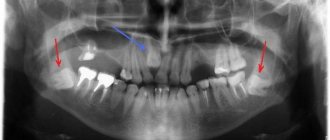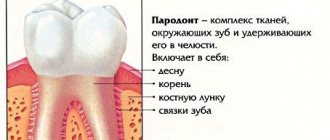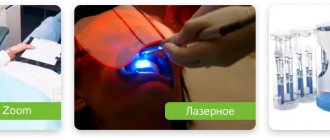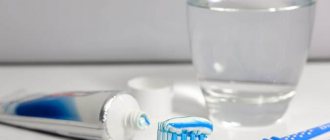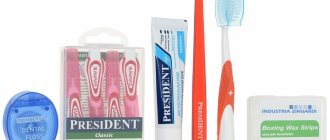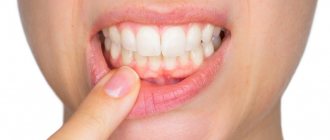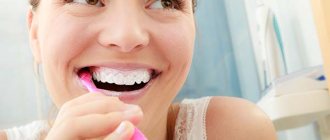Author of the article:
Soldatova Lyudmila Nikolaevna
Candidate of Medical Sciences, Professor of the Department of Clinical Dentistry of the St. Petersburg Medical and Social Institute, Chief Physician of the Alfa-Dent Dental Clinic, St. Petersburg
An annoying toothache after brushing is a very unpleasant phenomenon. It seems that it is possible to endure these sensations, but isn’t such persistence dangerous? Of course it is dangerous. Moreover, such abnormal reactions can indicate complex diseases of the teeth and oral cavity, which, without surgical treatment, will progress and destroy a snow-white smile.
Let's figure out why teeth start to hurt after brushing, how to cure such manifestations and avoid them in the future.
Why do you need professional teeth cleaning?
Diligent oral care does not exclude the formation of tartar, pigmentation and plaque. Everything that remains on the teeth after hygiene procedures mineralizes over time, forming hard particles. They hold on so tightly that it is not possible to remove them with a thread or brush.
Professional sanitation is carried out using different methods. It is impossible to say for sure which teeth cleaning is better. When choosing a method, the following factors are taken into account:
- oral health;
- the presence of pathological processes;
- contraindications to the use of a particular technique;
- availability of consumables in the clinic.
The importance of the procedure is to prevent the development of the carious process. It is the stone formed on the enamel that damages the bone tissue. This leads to tooth decay. Among other things, the pathology quickly spreads to neighboring units.
Many people are interested in how often to brush their teeth. It is enough to visit the dentist for high-quality oral hygiene twice a year. If you have problems with your gums, it is recommended to make an appointment for cleaning once every 3 months.
What the procedure provides:
- enamel whitening, dark stain removal;
- cleaning from mineralized deposits and dense deposits;
- prevention of caries, inflammatory gum diseases, including you may not need further treatment of periodontitis;
- preparation for complex dental treatment (fixed dental prosthetics, implantation, bite correction);
- eliminating unpleasant odor coming from the mouth.
Benefits of electric toothbrushes
Dentists recommend the use of electric toothbrushes, since thanks to the active air-droplet flow, which is ensured by an increased rotation speed, the teeth of all patients, including children, can be gently cleaned, and dentures can be cleaned without damage. In addition, disabled people, as well as people who have problems with the motor system or do not have sufficient skills to use small objects, will solve the important task of maintaining oral hygiene with the help of an electric brush. As a result of the benefits of an electric toothbrush : fast and high-quality teeth cleaning.
Another advantage of a toothbrush: tooth enamel is not damaged at all . The technology of the reciprocating rotational cleaning mechanism allows you to clean the interdental space while simultaneously naturally whitening the tooth surface. Modern models are characterized by additional functions, including, for example, the ability to brush your front teeth for 30 seconds using any of the available modes. The installed timer will allow you to complete the procedure in full, which is not always possible when cleaning yourself.
One of the distinctive advantages of using an electric brush is also the prevention of gingivitis due to the vibration effect on the gums. With constant use, frequent bleeding of the gums is eliminated.
Ultrasonic electric toothbrushes not only effectively clean plaque, but also destroy tartar and deep deposits. In combination with the use of dental floss, this allows you to maintain the health and beauty of your teeth and oral cavity, and as a result, the procedure for professional oral hygiene becomes optional.
To briefly describe the benefits of an electric toothbrush , it consists of the following advantages:
- High-quality teeth cleaning;
- Removal of dental deposits and tartar removal;
- Convenient and safe cleaning in the presence of braces or dentures;
- Prevention of gingivitis;
- Strengthening gums and improving their blood circulation;
- Convenient calculation of cleaning time thanks to the timer;
- Saving your own money on professional oral hygiene;
Among the expensive models, there are specimens that have a useful ultraviolet lamp for disinfection. Enabling this function allows you to independently disinfect the oral cavity, which provides a high level of protection against infection and the development of caries.
Types and differences of professional teeth cleaning
There are various ways to clean your mouth professionally. Each option has advantages and disadvantages. The choice of technique is made by the dentist.
Ultrasonic
It is performed using a special device - an ultrasonic scaler. The working element of the device is equipped with a nozzle that performs oscillatory movements at an ultrasound frequency of 25-50 kHz. The effect is enhanced by supplying an antiseptic solution or water through the nozzle. Deposits are removed under the influence of cavitation.
This method does not damage the enamel. When treating the oral cavity with an antiseptic, pathogenic bacteria are destroyed. The effectiveness is so high that it is possible to cope even with supra- and subgingival stones. The patient does not feel pain after brushing his teeth.
Laser
Removal of mineral deposits and plaque from the surfaces of the oral cavity is carried out under the influence of a laser beam. The liquid evaporates from them, as a result of which the destruction process begins. Peeled particles are removed with a stream of water supplied under high pressure.
The cost of the service is higher than alternative methods, due to the use of expensive equipment.
Sandblasting
Cleaning is performed using Air Flow equipment. The device even copes with old deposits. The main condition is that the coating must be soft. Air Flow does not remove tartar. The process of sanitation of the mouth involves the use of a special attachment, a mixture containing a fine abrasive, and a fixing gel. This method is used with caution in cases of increased sensitivity of the gums.
Chemical
The essence of the procedure is to apply a special gel containing hydrogen and acid to the teeth. During aging of the product, hard and soft deposits are destroyed under the influence of chemicals.
The method is painless and effective. But the interdental areas are poorly treated.
Mechanical
Sanitation is carried out using brushes and highly active pastes. This method requires more time than alternative options. But the result is high. However, in the process of mechanical impact with brushes, the risk of damage to the enamel increases. For this reason, specialists rarely resort to such cleaning.
How to treat and eliminate tooth sensitivity at home
Before starting therapeutic measures at home, you should consult with your dentist. Usually, doctors strongly recommend using only professional remedies to eliminate the problem. Among them:
- "Fluocal".
- "Diplen Denta F."
- "Profokar" and others.
Yes, they are sold freely in pharmacy chains, without a prescription, but it is still necessary to first listen to the recommendations of a specialist. After all, these drugs are characterized by a high fluoride content, and this substance may be contraindicated in some categories of patients.
Remember, hypersensitivity itself is not a disease. But it is precisely this that acts as a consequence of the course of pathological processes. To reduce the risk of dental problems, you must first make an appointment with a doctor.
When starting home therapy, do not forget that you have to strengthen and restore dental elements not only from the outside. Their condition is directly affected by everything that happens to our body from the inside. To speed up recovery, you should take medications prescribed by your doctor, and also review your diet plan and introduce foods enriched with beneficial compounds into it.
If hyperesthesia worsens, try to eliminate possible irritants. In some situations, it is advisable to choose a brush that is more suitable for hygiene procedures.
When figuring out how to relieve severe tooth sensitivity at home, and what to do if alarming symptoms appear, do not forget that you need to strengthen not only bone tissue, but also gums. After all, the health of the oral cavity largely depends on their condition.
Contraindications to the procedure
Like any medical procedure, teeth cleaning in a dental clinic has a number of limitations:
- increased sensitivity;
- the presence of erosion processes on the enamel;
- inflammation of the oral mucosa;
- history of arrhythmia;
- epilepsy;
- acute infectious diseases;
- diabetes;
- bronchial asthma, occurring in severe form;
- chronic rhinitis (including runny nose due to ARVI).
Ultrasound and Air Flow services are available to patients over 14 years of age.
When bleeding is not associated with gum inflammation
In some cases, bleeding gums may not be associated with problems in the oral cavity, but indicate that a person needs to pay attention to his own health. For example, gums bleed due to a severe lack of vitamins in the body. This can be noticed in the fall or spring, when vitamin deficiency is pronounced, and the immune system is weakened and susceptible to exacerbations of chronic diseases.
A number of diseases are accompanied by bleeding gums, such as diabetes. People who have problems with the gastrointestinal tract and kidney disease also note weak gums and bleeding. With age, calcium is washed out of the body, which leads to osteoporosis, that is, weakness of bone tissue. In this case, the jaw bones also become thinner, hence sensitivity and looseness of the teeth and bleeding.
Blood during brushing is also observed in the presence of endocrine diseases, malignant tumors, leukemia and hemophilia. In such cases, if you notice blood in your mouth, you need to visit a therapist who will prescribe an additional examination to find out the problem.
It also happens that a tooth bleeds in a certain place due to an incorrectly placed filling or crown. In this case, the edges of the installed patch rest against the gum and injure it. You can correct the situation in the dentist's office. The doctor carefully grinds off the excess filling, and the gums will heal.
Stages of the procedure
Professional sanitation of the oral cavity is carried out in stages.
Stage 1: Comprehensive inspection
It is performed using modern instruments to identify deposits and assess the condition of tissues.
Stage 2: removal of soft and hard formations
To obtain high results, two methods are combined: ultrasonic cleaning and Air Flow. The first option destroys the structure of tartar, the second removes plaque and remaining stone.
Stage 3: Polishing
The enamel is polished using special brushes and paste. The surface is smooth and shiny.
Stage 4: fluoridation
To protect bone tissue, a gel or varnish containing a high concentration of fluoride is used.
How do children brush their teeth?
Ultrasonic cleaning and Air Flow are not prescribed for children under 14 years of age. Professional sanitation of the oral cavity is performed using special brushes and paste. After dental treatment, the surface is coated with fluoride-containing gel to strengthen the enamel.
Is it painful to have professional cleaning?
Patients often wonder if it hurts to have their teeth cleaned at the dentist. Regardless of the method used, there is no pain. A feeling of discomfort may occur when removing mineralized formations. In this case, ultrasound is prescribed. Ultrasonic teeth cleaning is also recommended during pregnancy and increased tooth sensitivity.

